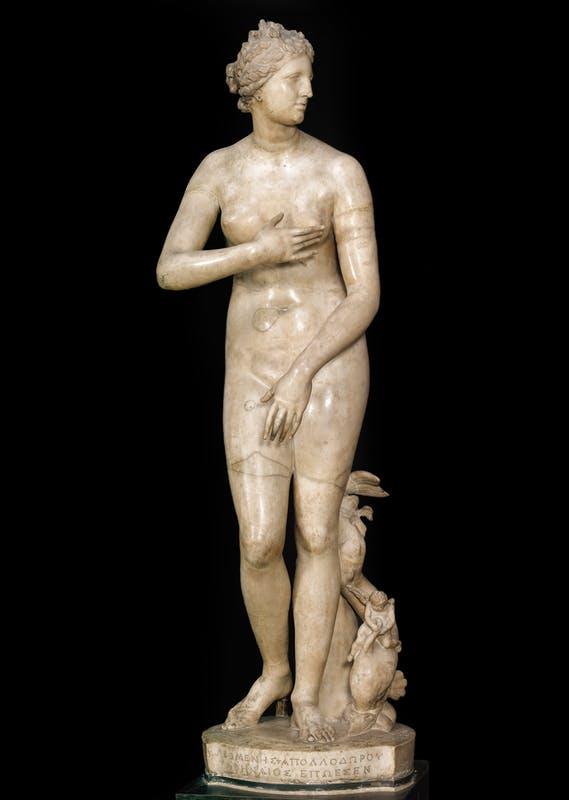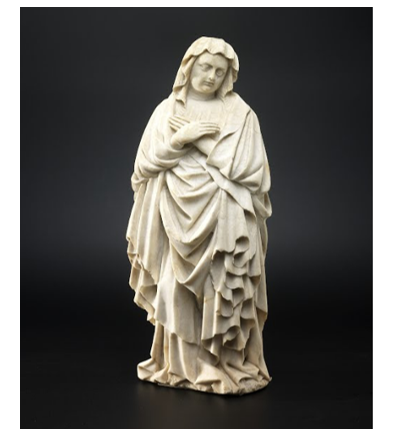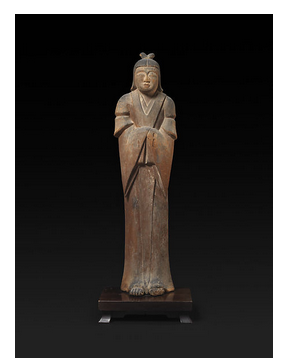Art from Roman Empire

- Title: Medici Venus;
- Date: Late 2nd century B. C. – Early 1st century B. C.
- Medium: Parian marble, lychnite variant;
- Current Location: Tribuna;
- Culture: Greek;
- Size: 153 cm (height).
Art defines every political, social, cultural, and economic state of a society or a community at a specific time that it was produced. Representation of women in art history discussed in this essay is as well particular to the period the art existed in the mentioned society. The female figure is the prominent topic focused on in this essay discussion. The essay consists of three images discussed from three different periods from ancient to medieval times, their meanings during the specific times, and their significance. The image discussion is based on the female figure from head to toe, the materials they are made of, and their representations in the specific cultures. The importance of the images at the particular periods in which they existed is also addressed.
Group 1 image is from the Roman Empire depicting the representation of the female figure in the empire. The image from group two is a female figure art representation from the early Christian describing the position and role of women in the mentioned era. Women and spirituality are addressed in the group 2 image. Lastly, the group 3 image is from Japan in the period before 1333. All the pictures from the three groups depict different representations of the female figure in the respective societies and communities at the identified periods. The chosen images illustrate the position and roles of women in the three communities. Modeling and expression of women characters are also depicted in the art history of the photos.
In Roman Empire, there were women legends that displayed many things, such as their virtue, that women from society were anticipated to copy. Every woman in the Roman Empire was expected to be aware of the kind of information and massage every legend was passing to them. There were women who were able to meet the standard and were appreciated, while those who did not take away their own lives.
The Roman Legend virtues were highly considered and continued until the end of Ancient Rome. Different legends displayed different information on the character of women; the displayed characters had an impact on real women during that period. Legends held a special place in the Roman Empire and were honored by everyone in the society. To date, the Romans still give special honor to the tales, especially women; their characters are still being shaped by the myths stories from the archives.
Venus de Medici is one of the Roman goddesses known in the Roman Empire, and his image is used to teach Roman women several things. This is because Romans granted great respect to their goddess to the extent that they taught their women to follow their virtues. The image of Venus is used to depict confidence as women were expected to be of courage, and this increased the kind of respect men offered to the female gender. The image motivated women to emerge as heroes that became legends in the Roman Empire. Because of this, men became insecure as their women progressed to be more robust (Franks, 2020).
The goddess in Rome displays virtues such as purity, maturity, and good morals. Hence, women who followed the goddess’s virtues were treated with respect and treated in a better way than their men during that time. This is because Roman people respected their goddess; hence every woman following the virtue of the goddess had to be respected. Generally, the Vinci female figure helped in molding women into the high status and confident gender in the Roman Empire.
Women were not viewed as lesser beings if they followed Vinci’s examples. The image does not depict a natural person as it refers to a goddess in Roman Empire during the 18th century period. The marble medium looks appealing to the female figure. The size of the image is primarily due to the marble medium used. From seeing the picture, courage is depicted by the portrait of the female figure. The female figure stands courageously representing how women were expected to be courageous despite the myth of women being fearless and weak.
Art from Early Christian Byzantium

- Title: Virgin Mary.
- Date: Circa 1425-1430.
- Location: Museum of Slovenia.
- Culture: European.
- Medium: Alabaster.
- Dimension: h. 37.2 cm.
Virgin Mary is depicted in Group 2 image. This particular image can be placed in the beginning of the Christian era, where it depicts both the role and position of women in accordance with their spirituality. Virgin Mary was the mother of Jesus, from biblical references. At the beginning of the Christian era, Mary was conceived by the Holy Spirit, therefore, giving birth to Jesus, the son of God. Both her humility and obedience to the word of God gave her a special image to all Christians, to even being chosen by God. Virgin Mary represented a virtue of purity among women in the Christian era since she was a virgin while being betrothed to Joseph, her husband. Virgin Mary was also known widely as the Blessed among all women and also Mother of God.
From the image, the Virgin Mary is seen dressed in a translucent gleam-colored dress, falling in a loose-fitting design. Her head is covered in a veil such that not even a strand of hair can be seen. The piece of clothing covers most of her body parts, save for the hands. The Virgin Mary’s image as a piece of art depicts a real person who existed between 18 B.C and 33 A.D. She was a Galilean Jewish woman from the town of Nazareth. Virgin Mary was the Holy Mother of Jesus and is considered the greatest and the most blessed being among all women. This particular identity of the Virgin Mary influenced the artist to depict her as a humble servant of God, yet human. The artist chose her as she was viewed as the most powerful intercessor among all saints.
The medium of the work used is alabaster. Alabaster material is a soft white stone, sometimes some are translucent. It is marble-like and finely grained. The choice of this medium is important because of its softness. Many elaborate and significant pieces of art can be carved out of alabaster because of their ease to be carved. As seen from the Virgin Mary’s image, the medium chosen, in this case, alabaster, influenced its color, to become white.
A subtle gradation of relief of varying depths was achieved in the sculpture solely due to the use of alabaster. The choice of color in this image is thought to be white to almost translucent. The color white depicted purity as was the case of The Virgin Mary. The Virgin Mary is seen to be holding her hands close to her chest, her eyes closed and head facing down. This is depicted to show her praying. The facial features used show her face in deep meditation to a higher being. This was to signify the Virgin Mary as a woman of faith in the biblical era
Art from Japan Before 1333

- Title: Female Shinto Deity.
- Date: ca. 1000–1200.
- Medium: Wood with traces of color.
- Dimensions: H. 38 1/2 in. (97.8 cm); W. 9 3/4 in. (24.8 cm); D. 5 in. (12.7 cm).
- Culture: Japan.
- Current Location: Japan.
The female Shinto deity is an image of the female figure in Japan before 1333 depicting a noblewoman. The female Shinto is a goddess whose name is not known. From the figure, the female is dressed in a garment with long sleeves representing robes that were worn by deities who were female Buddhists. This depicts the nobility of women during that period in Japanese culture. The dress looks like a thick kimono. The Japanese society worships many spirits during this era that took the form of nature, such as mountains, trees, rocks, and waterfalls. In the 9th century, the human form of the spirit was created to be a female Shinto deity.
The creation of the image informs of a female and not a male implied an exaltation of females as noble gender in the places of worship. The kind of Shinto image dressing from head to toe shows a worship style of dressing or rather a holy gesture (Tazuru & Sugiyama 2019).
From the image position of a spirit in the female figure, the Japanese community viewed women as channels connecting men and hearts. For men to perform the heart’s will, they needed a connection to the spirit that was believed could only happen through women. Both women and men making the Japanese Shinto make a female figure goddess viewed priesthood as a role that should be performed. The female figure image shows royally, which justifies the Japanese belief during the 7th century that the emperor’s sisters could easily connect the emperors with the spirit. During the 7th century, women assisted in the holy site of the shrine by acting as deputy priests. The female figure is dressed in a sacred appearance to mean that women could be allowed to participate in the religious activities of the shrine.
The image is not depicting a natural person; and it is a female goddess image. It is a goddess image; the artist’s depiction of the picture is influenced in a way that instead of it looking like an actual woman figure, it is overrated with wing-like structures around the hands and waist. The wing-like design makes the image look like a unique being among the spirits. In actual fact, a woman can never have wing-like structures on them. The goddess nature influences the women’s depiction as highly spiritual and holy characters, though; women cannot fit being categorized among the spirit beings. The image looks large in size due to the wood material used. The wood used on the figure is a heavy thick material increasing its size.
Similarities
Status of the Women
All the three women as shown were held in high esteem. In ancient times, they were considered with respect and dignity. Women were the mirror of society. They were almost the moral compass of the whole community. Children were taught how to follow in their footsteps.
Considered Higher Beings
Both the three women were considered as goddesses. They were not viewed as normal human beings. They were either considered to be more spiritual or touched or influenced by God. They were even worshipped and thought as intercessors. Prayers were done through them, including sacrifices and gifting.
Differences
Medium of Sculpture
Venus de Medici is carved in marble because of the translucency and durability of marble. Its resistance to shattering, waxy look and finer grain make it suitable for the said sculpture. The Virgin Mary’s sculpture on the other hand uses alabaster. This is because of the alabaster’s ease of carving, its softness and relief of varying depths. The sculpture of the Female Shinto Deity uses wood with traces of polychrome. This is because wood offers strength and durability. Wood is also natural, warm and comfortable to work with.
Religion
Each of the images represents a different religion and culture. Virgin Mary is depicted in the Christianity religion at the beginning of the first century. She is the mother of Jesus, who is believed by Christians to be the Son of God. The female Shinto Deity on the other hand is hailed to be from Buddhism. Lastly, Medici Venus represents the Greeks in the Roman Empire.
Summary
Art has been used by different cultures to depict several figures. Women have been used so much in the art to display pretty pictures with different meanings. From ancient times women have been used in art history to explain the purpose of their appearance and roles in society. Arts of different cultures and societies portray different meanings of women’s parts from head to toe. The materials used in women figures in art as well represent meanings specific to a particular community. Women’s status in society has been defined by the different female figures in art.
Art and design play a significant role in history, as depicted in the cases of female figures discussed in the essay. The position of the female gender in the community is displayed from the three groups concerned specifically to the mentioned societies in the different specific eras. From history, arts help understand the current position of women in the organization derived from the ancient view. Though contemporary society views women as lesser in most areas, the use of art history can change this perspective. As well, women have currently deviated from the values depicted by the images, and digital people no longer refer to account. Art and history education should be adopted once more to bring back the nobility in women.
The female Shinto deity figure is the best of the three groups since it depicts a woman’s mobility. Though all the images show women with a lot of importance, the weight of the Shinto deity depiction is outstanding. The appearance of Shinto is more appealing compared with the other images. Shinto also displays that women are not any lesser than men; this is interesting as women get a sense of responsibility. Contrary to different societies across the globe that have always viewed women as lesser beings compared to men, the Shinto deity can be used as a figure to empower women. For sure, women are noble characters, and the world would not be a better place without them.
References
Franks, H. M. (2020). As Nature Formed It: Venus Sculptures and the ‘Natural ‘Waistline in Dress Reform Discourse. Classical Receptions Journal. Web.
Schlau, S. (2020). Immaculate Conceptions: The Power of the Religious Imagination in Early Modern Spain. Web.
Tazurú, S., & Sugiyama, J. (2019). Wood identification of Japanese Shinto deity statues in Matsunoo-Taisha Shrine in Kyoto by synchrotron X-ray microtomography and conventional microscopy methods. Journal of Wood Science, 65(1), 17. Web.